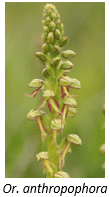COTTE:
The vegetation of the site is very diverse, due to the simultaneous presence of numerous structural and physiognomic types such as grazed and/or mowed grasslands, shrublands, patches of woodland or open scrub, forest edges and margins and, to a much lesser extent, cultivated fields and urbanised environments.
Sub-mountain woodlands dominated by oaks (Quercus pubescens and Q. cerris) with associated mesophyll elements such as hornbeam (Ostrya carpinifolia), various maples (Acer campestre, A. opalus subsp. obtusatum, A. pseudoplanatus), greater ash (Fraxinus excelsior), cherry (Prunus avium) field elm (Ulmus minor), etc.
In the undergrowth, vegetation is typical of oak forests, e.g. Viola alba Besser subsp. dehnhardtii, Aegonychon purpurocaeruleum, Daphne laureola, etc.
Scattered shrublands are dominated by common juniper (Juniperus communis) or roses (Rosa sp. pl.) and hawthorns (Crataegus monogyna, C. laevigata).
The grasslands are mostly dominated by Bromopsis erecta with abundant Pentanema salicinum and Brachypodium rupestre.
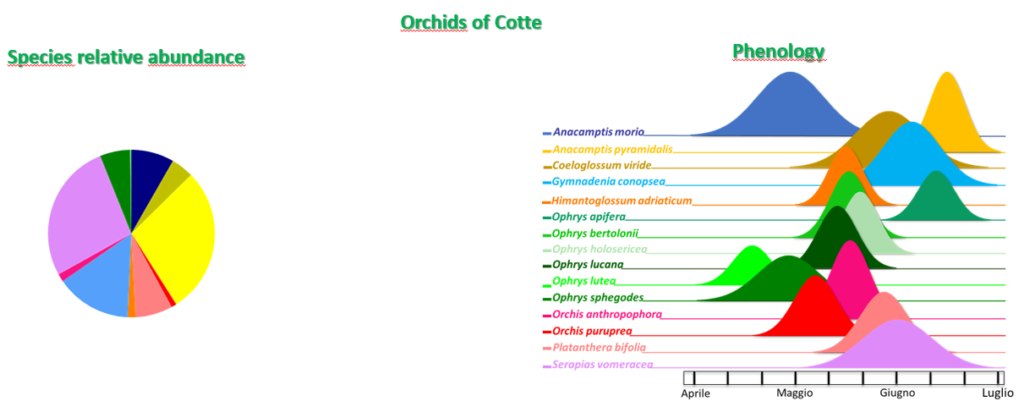
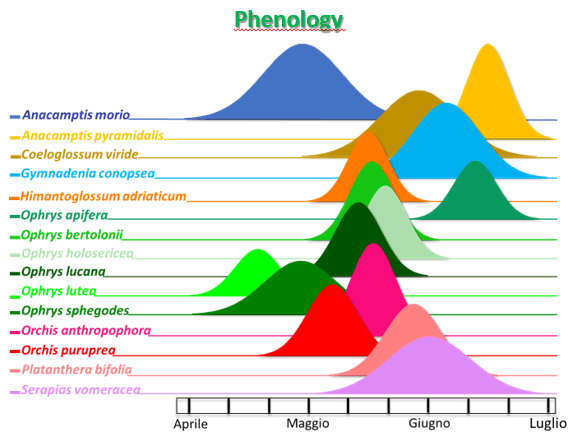
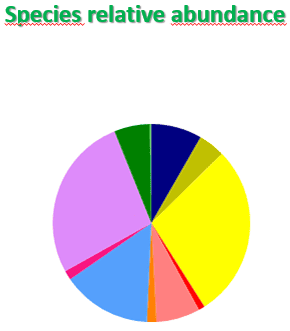
Description of the species
Anacamptis morio
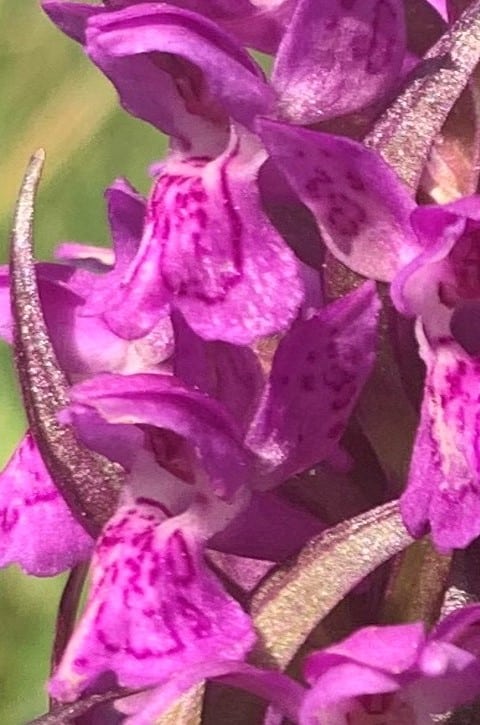
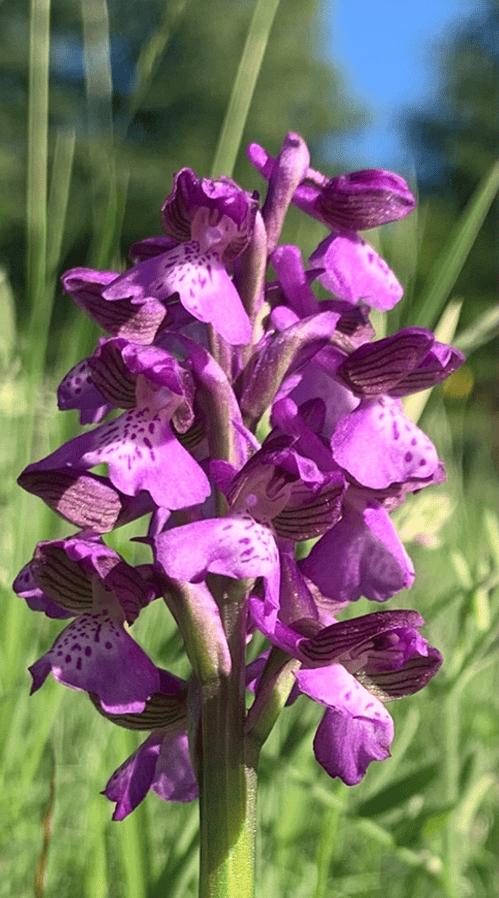
Anacamptis morio
Etymology: the origin of the specific epithet is currently unclear. The term morio may derive from the Latin morio-onis (clown), because of the spotted flowers resembling the clothes of a clown, or morrion from the Spanish (helmet) because of the way the tepals are arranged.
Description: a medium perennial up to 35 cm in height. The scape, ranges from green to purplish. The lower leaves are lanceolate and arranged in a basal rosette, while the upper leaves wrap around the scape. The inflorescence consists of 5 to 25 flowers. The flowers are purple in colour; white flowers are not uncommon. The tepals are almost always streaked with green. Lip bluntly 3-lobed and almost folded in 2, the edge is crenulated, the central part paler than the margins characterized by many small purple maculae. Pollinated mainly by bees.
Anacamptis pyramidalis
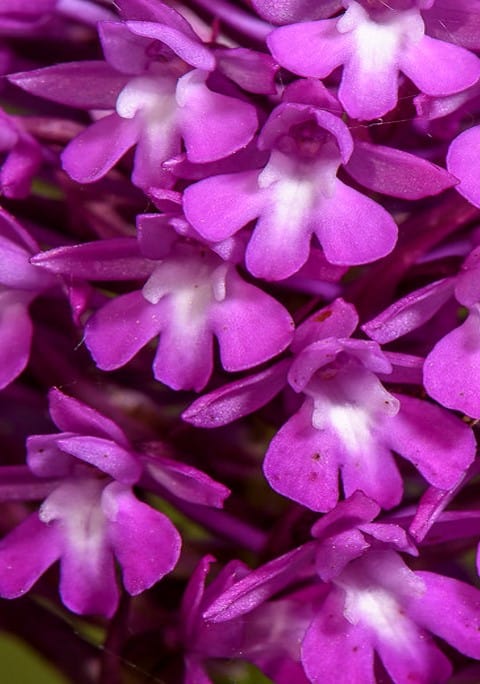
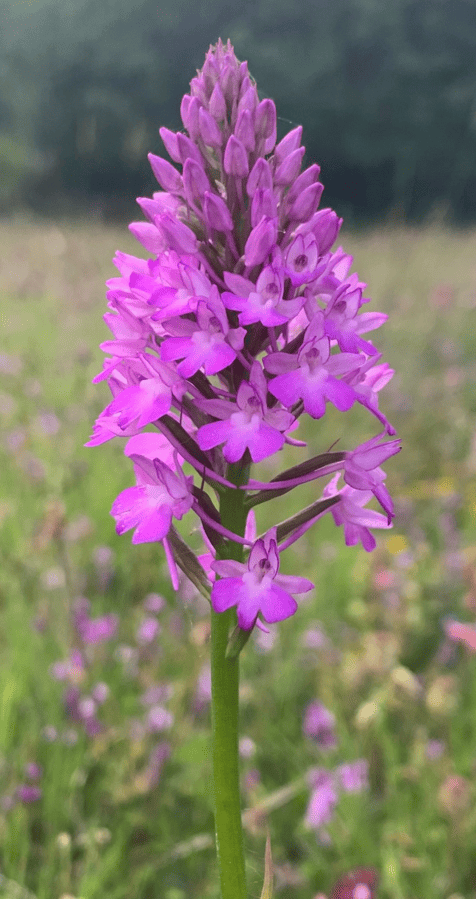
Anacamptis pyramidalis
Etymology: the specific epithet is of latin origin pyramidalis (pyramidal). The name was given to it due to the cone-shaped inflorescence.
Description: a plant that can reach up to 60 cm in height. The green scape is very thin. The lower leaves are lanceolate, up to 25 cm long and not arranged in a basal rosette, along the scape the leaves are fasciated and small. The inflorescence can consist of up to 100 small flowers. The colour of the flowers varies from pink to purple, and rare are white flowers, borne in distinctly cone-shaped or dome-shaped dense spikes. The lip is 3-lobed and the central lobe is less wide than the lateral one. The spur is very long, ribbon-like, that exceeds the length of the ovary.
Coeloglossum viride
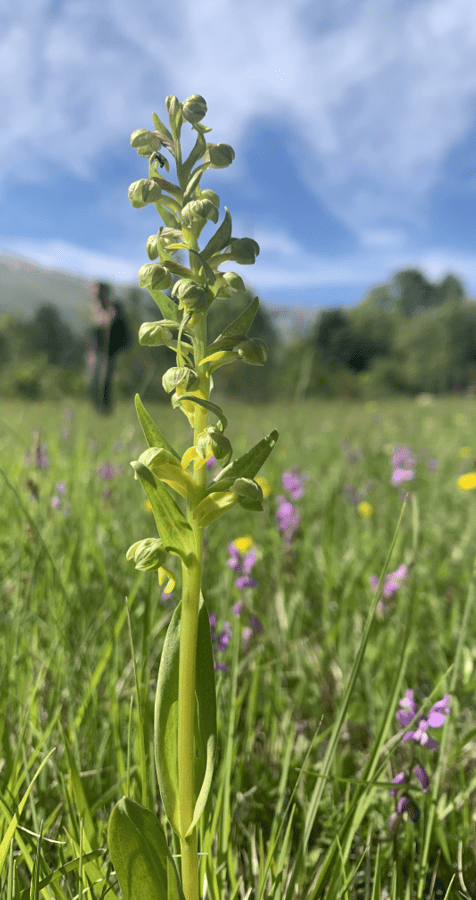
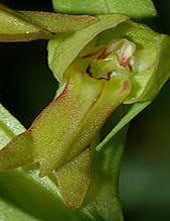
Coeloglossum viride
Etymology: Coeloglossum derives from the greek Koilos-glossa (from the hollow tongue) and viride from the Latin viridis (green) due to the green colour of the flowers.
Description: plant up to 35 cm high. Green, grooved stem. The lower leaves are ovate while the upper leaves are lanceolate and acute. The inflorescence is loose with up to 25 flowers. The flowers are light green, and the sepals and petals are grouped to form a helmet around the lip.
The lip is pendulous, tongue-shaped, 3-lobed, and green with brownish-red shaded margins. The lateral lobes are longer than the median and are slightly bent forward. Spur small, sac-like and nectariferous. Gynostemium small and pollen diverging downwards.
Gymnadenia conopsea
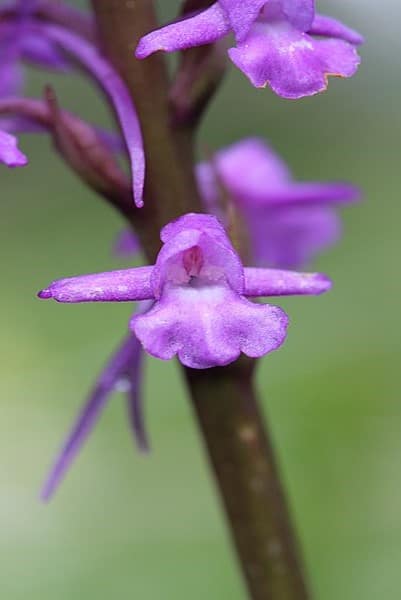
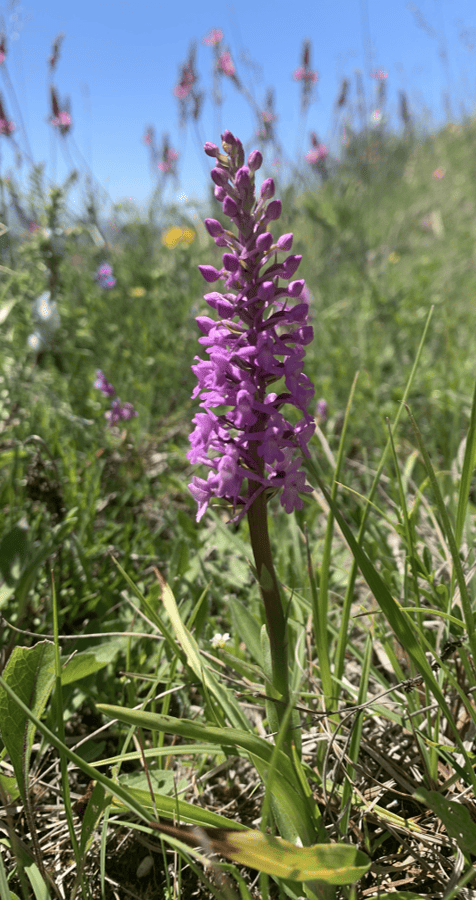
Gymnadenia conopsea
Etymology: the term conopsea is derived from the greek konops (mosquito) from the appearance of the spur that resembles the mouthparts of mosquitoes.
Description: plant up to 1 m high. Scape erect, flexuous light green at the base and purplish at the apex. The lower leaves are long, linear and lanceolate, and the upper ones are bract-shaped. Inflorescence dense and elongated with small, fragrant flowers, varying in colour from pink to purplish red, rarely white. Lateral sepals are long, and the median one curved forward, united with the petals to form a helmet. Lip 3-lobed, lobes very similar to each other. Spur very long, filiform, downward-pointing, containing little nectar.
Himantoglossum adriaticum
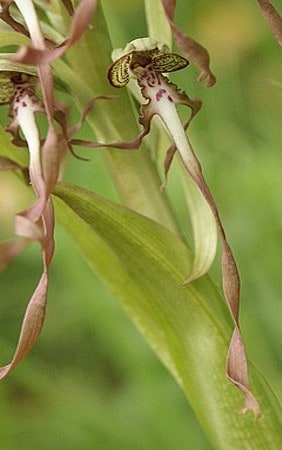
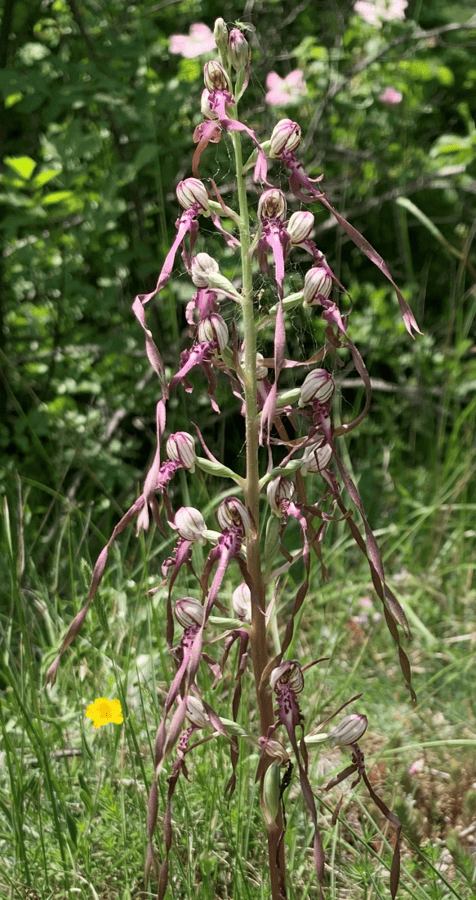
Himantoglossum adriaticum
Etymology: the term Himantoglossum derives from the greek (ribbon-tongued flower).
Description: a plant up to 90 cm high, the scape is green and sometimes purple shaded. It has ovate lower leaves, while the upper leaves band the stem. The inflorescence consists of 15 to a maximum of 40 flowers. The tepals are green with purple streaks that join to form a helmet around the lip. The lip is 3-lobed and has a white base with purple maculae, the median lobe is thin ribbon-like, bifid at the apex and up to 65 mm long. Spur 2 to 4 mm long. The flowers, although poorly nectariferous, are very fragrant and attract a pollinators from various families: Hymenoptera, Diptera, Coleoptera, etc.
Ophrys apifera
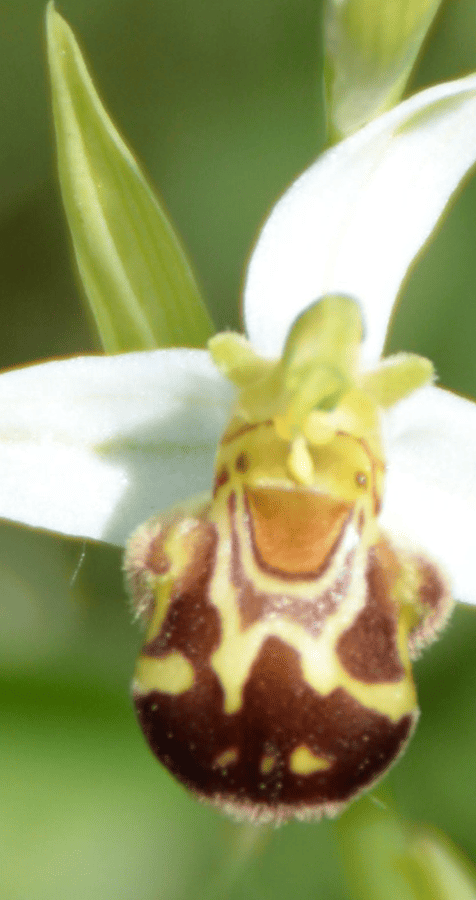
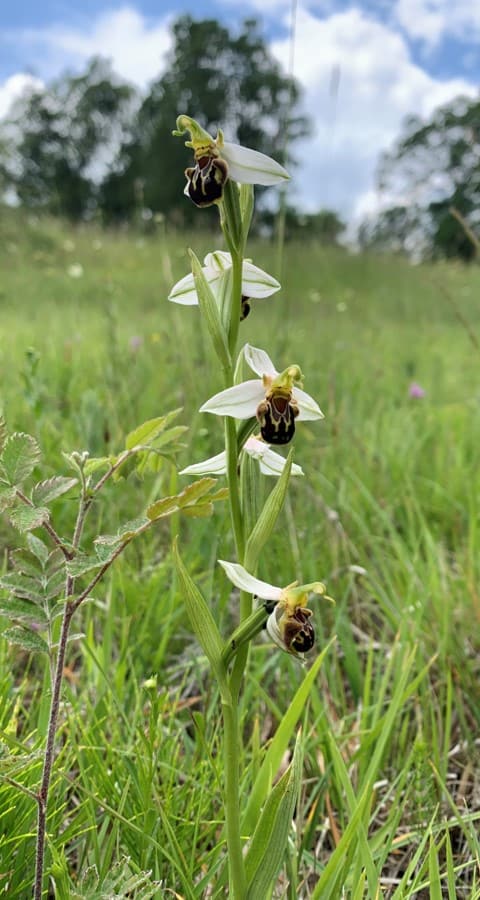
Ophrys apifera
Etymology: The term apifera derives from the latin apis and fero (bee-bearer) due to the resemblance of the flower to the bee.
Description: plant up to 60 cm high. Scape robust, light green, light green leaves clustered in a basal rosette. Inflorescence lax with 2 to 10 flowers. Flowers are relatively large with sepals of various colours from white to pink, with a green centre rib. Petals are very small, green, and triangular. The lip is velvety 3-lobed brown, with small, hairy lateral lobes. The median lobe is round and has a poorly articulated speculum, bordered by a very thick yellow line. Acute rostrum gynostemium with the typical shape of an S.
Ophrys bertolonii
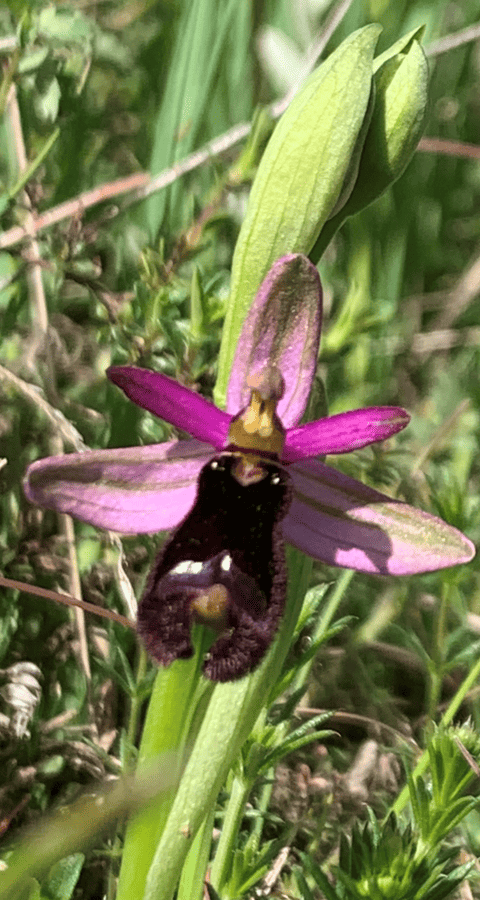
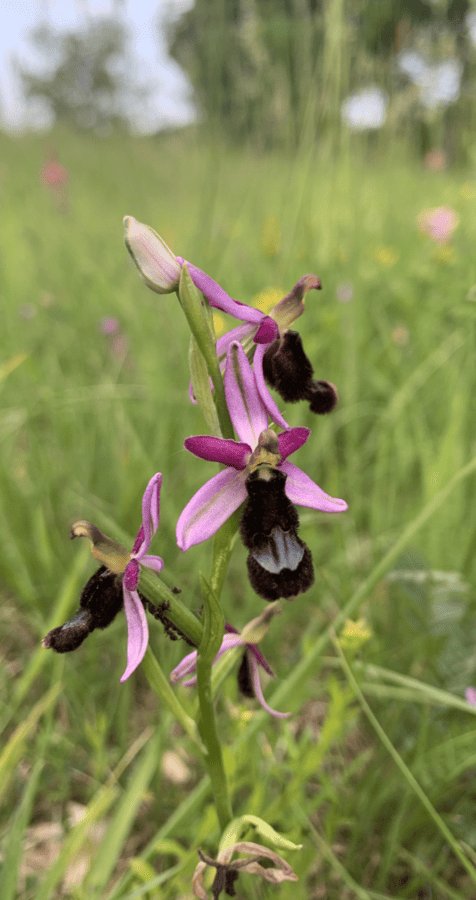
Ophrys bertolonii
Etymology: the name was given to honour the famous botanist, Antonio Bertoloni.
Description: a plant up to 90 cm high. Stem green and slender. Leaves arranged in a basal rosette. The inflorescence consists of 2 to 8 large flowers. The sepals are pink, while the tepals are a deeper pink than the sepals and are sometimes purple. The entire, black labellum has the typical saddle shape covered with reddish-brown hairs on the margins. At the base of the labellum, there is a shiny shield-shaped speculum of a blue-red colour. The apicle is very large and green to yellow in colour, facing upwards or forwards. Gynostemium elongated and pointed.
Ophrys holosericea
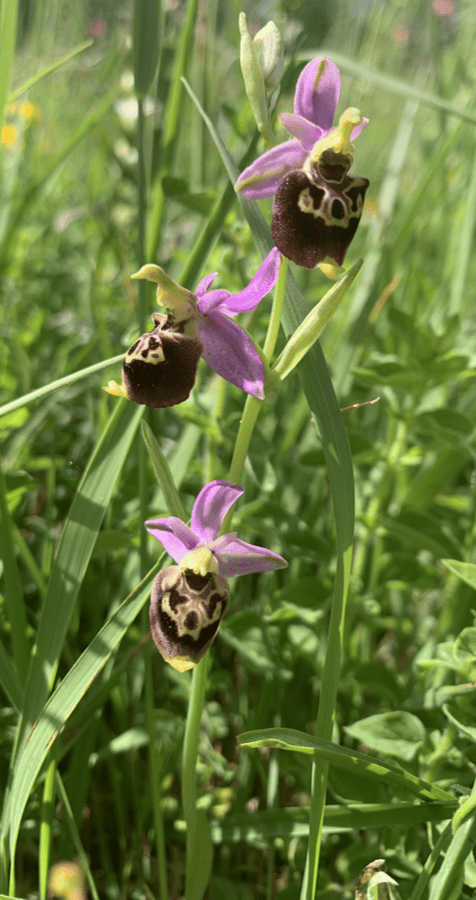
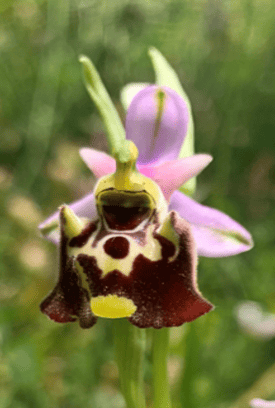
Ophrys holosericea
Etymology: holosericea derives from the greek holos-e (all) and serikos (silk), due to the velvety appearance of the labellum.
Description: This species is characterized by its high morphological variability which has led many authors to describe different infraspecific entities. Plant up to 40 cm high. Erect and light green scape. The lower leaves are almost all united to form a basal rosette, and the upper leaves are enveloping the scape.
The spike-like inflorescence may consist of 2 to 10 flowers. Sepals are ovate and may be white, pink, or purplish red with green veins. Petals are subtriangular, pink, or purplish red and rarely white. Lip downwards, velvety with brownish marginal hairiness with more or less evident basal gibbosity. The speculum is very variable in shape, brownish-red in colour with white or yellow margins. Apicle is very developed facing forward and yellowish-green above. Gynostemium is short and acute.
Ophrys fusca sub. Lucana
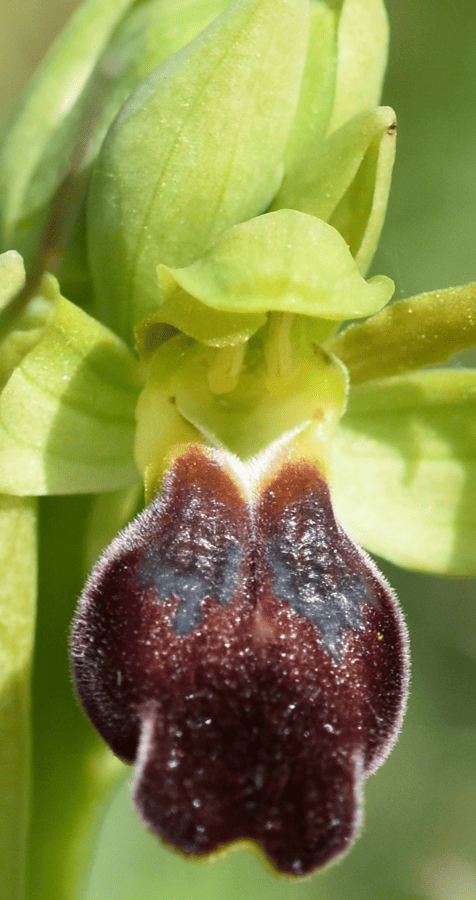
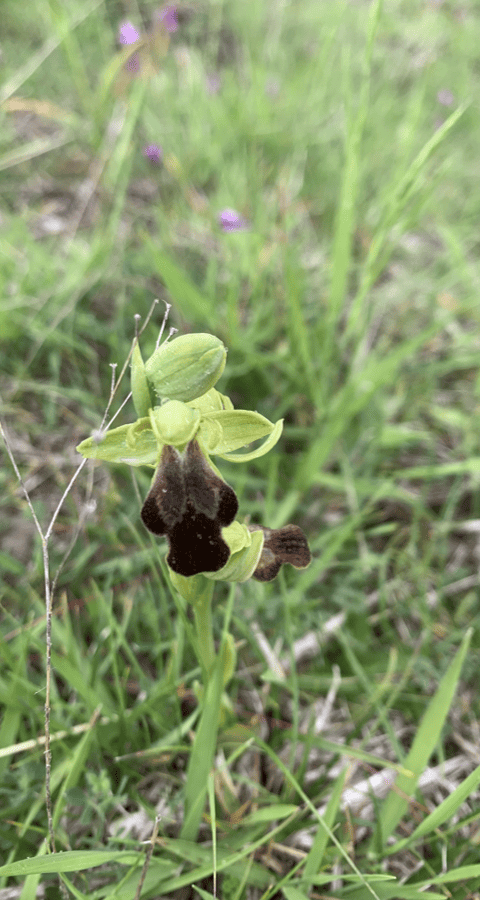
Ophrys fusca sub. Lucana
Etymology: the epithet fusca derives from the latin fuscus (dark), due to the dark colour of the labellum. The name lucana, on the other hand, is linked to the name of the place where it was first sighted in Basilicata.
Description: plant up to 25 cm high. Stem thin, light green. The lower leaves, oblong-lanceolate, are arranged in a basal rosette. Inflorescence dense and may have 2 to 8 flowers.
The flowers are large and dark. Tepals are yellowish-green in colour, and the middle one is curved on the gynostemium. Lip brown, and velvety with a distinct yellow edge. Speculum covers about two-thirds of the entire lip and is metallic grey in colour and rust red towards the base; the stigmatic cavity is also characterized by whitish hairiness.
Ophrys lutea
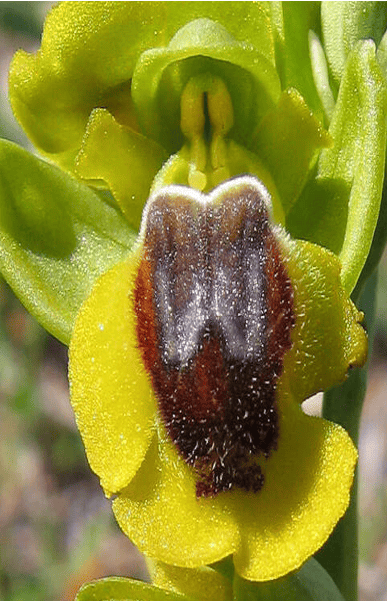
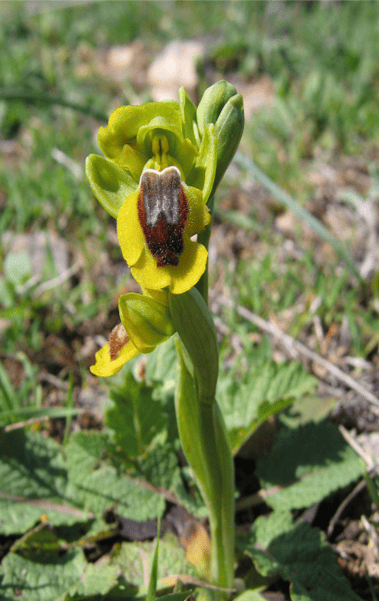
Ophrys lutea
Etymology: The epithet derives from the latin luteus (yellow) due to the colour of the lip.
Description: plant up to 30 cm high. Lower leaves grouped to form a basal rosette. Inflorescence lax with 2 to 6 flowers. The flowers are large, the sepals are green, and the petals are yellow. Lip 3-lobed has yellow margins and is brownish in the centre and lateral lobes are slightly spaced from the median one. Short gynostemium with obtuse apex.
Ophrys sphegodes
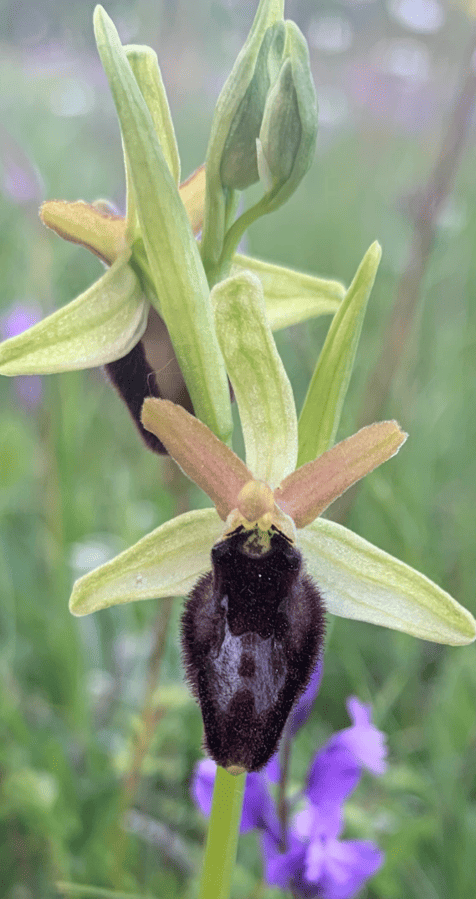
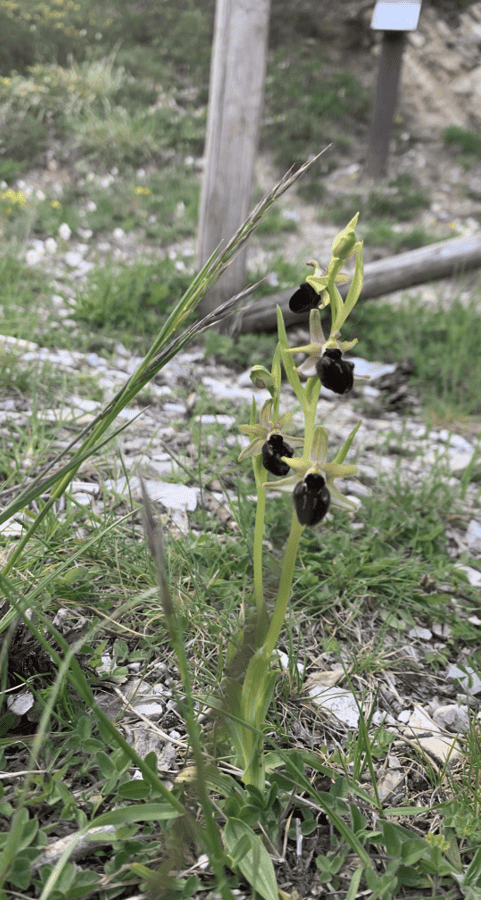
Ophrys sphegodes
Etymology: the epithet sphegodes comes from the greek sphekos, meaning wasp-like.
Description: plant up to 55 cm high. Slender green scape. The lower leaves are clustered to form a light green basal rosette, and the upper leaves wrap around the stem. The inflorescence may consist of 2 to 15 flowers. Sepals green, the middle one slightly forward-facing; the petals are smaller with slightly pinkish, wavy margins. The lip is large and downward-facing, highly variable in shape and colour, with marginal hairiness. The margin is often bordered by a yellow line. It has a brownish or dark blue H-shaped speculum. Greenish and very conspicuous gynostemium.
Orchis anthropophora
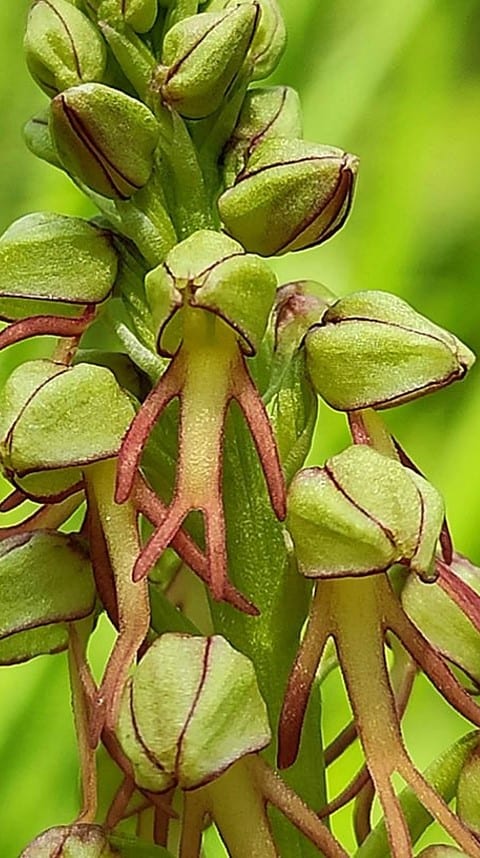
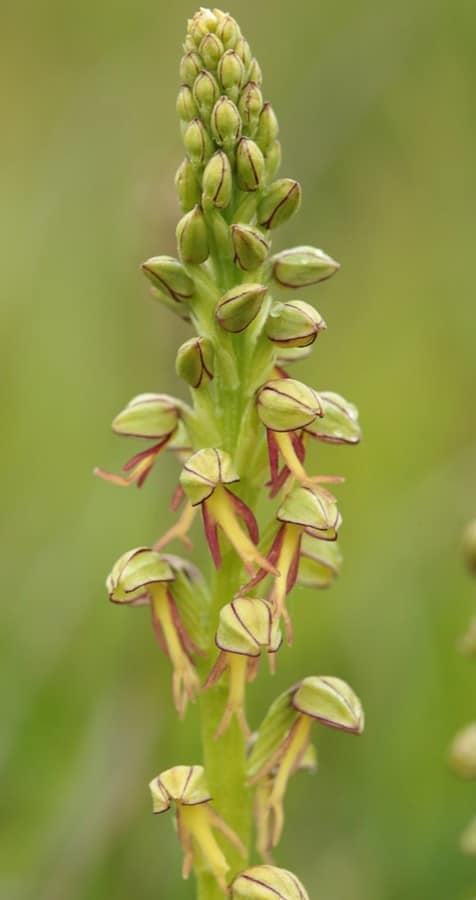
Orchis anthropophora
Etymology: the epithet anthropophora derives from the greek (“man-bearer”) due to the shape of the lip, which seems to imitate the body of a man.
Description: plant up to 40 cm high. Slender, light green stem. The lower leaves are ovate and clustered to form a basal rosette. Inflorescence narrows at the base and gradually widens towards the apex. Sepals and petals are united to form a yellow-green helmet with red margins. The lip is pendent, downward-facing, and 3-lobed; the central lobe is longer than the lateral ones and is bifid. Absent spur and small gynostemium.
Orchis purpurea
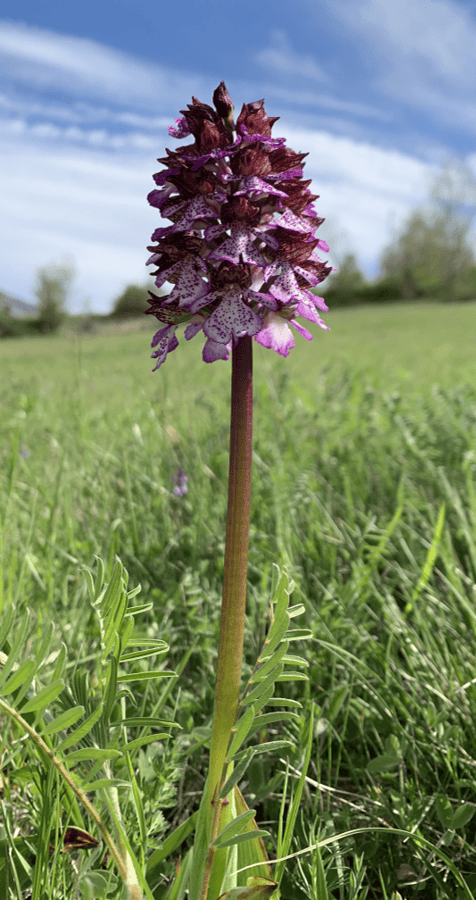
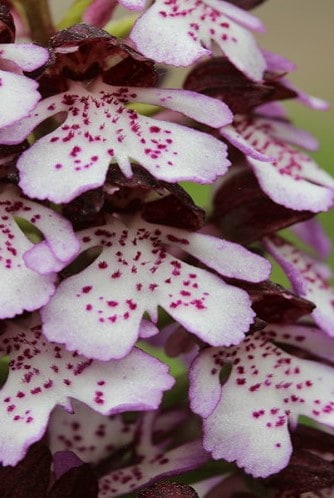
Orchis purpurea
Etymology: The epithet purpurea comes from the latin purpureus-a (purple) given the colour of some parts of the flower.
Description: plant up to 80 cm high. Robust, cylindrical scape green at the base and tinged with purple at the apex. Large, oblong, glossy green lower leaves are arranged in a basal rosette, the upper leaves wrap around the stem. Dense inflorescence with large purple-pink flowers. Sepals and petals are united to form a helmet on the greenish lip with obvious purple streaks and maculae. The lip is 3-lobed with a white or shaded pink background with conspicuous purple maculae and purple margins. Spur not longer than the ovary, curved downwards and obtuse gynostemium.
Platanthera bifolia
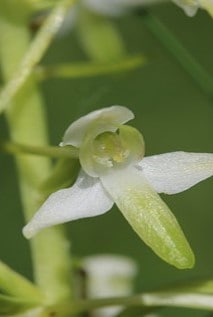
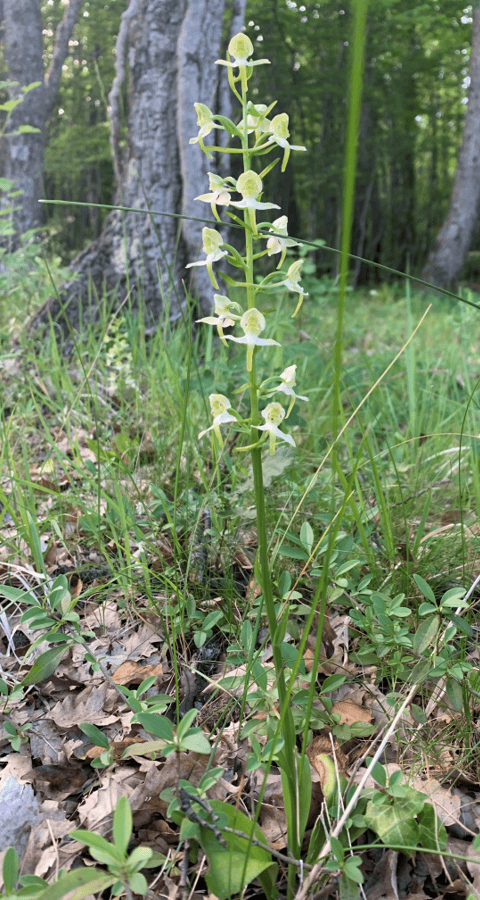
Platanthera bifolia
Etymology: the epithet bifolia comes from the latin word meaning two leaves because this plant has two large leaves at the base.
Description: plant up to 50 cm high. The scape is slender and light green in colour. The leaves at the base are large, oblong-lanceolate and glossy. The slender, cylindrical multi-flowered inflorescence may consist of up to 40 very fragrant flowers. The tepals are white slightly tinged with green. The median tepal is shorter than the others folded forward. The lip is pendulous, and white with the tip shaded green. The nectar spur is long, slender and longer than the ovary.
Serapias vomeracea
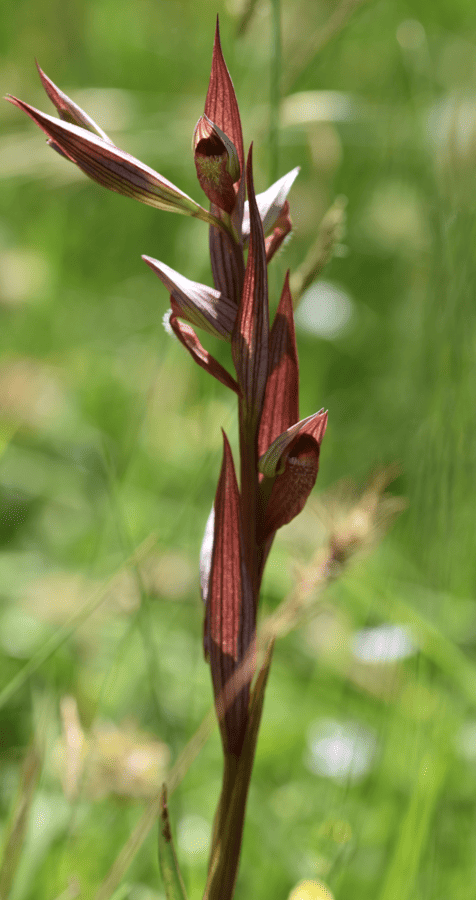
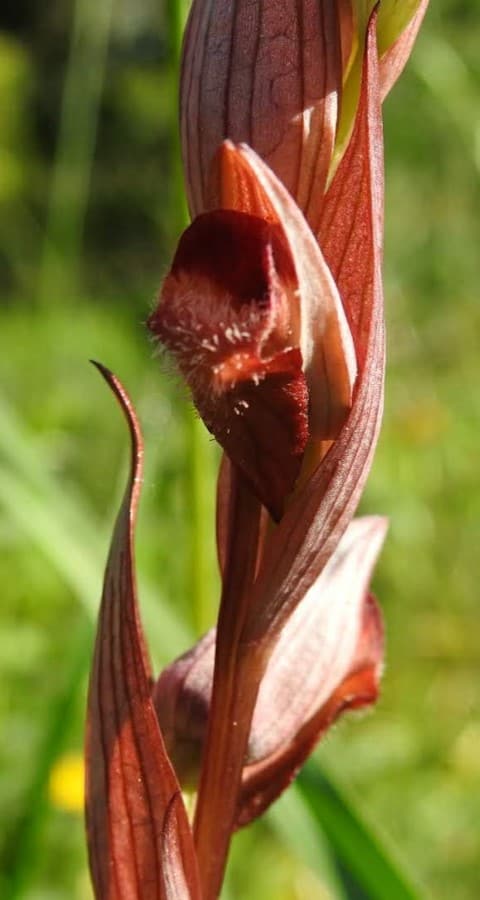
Serapias vomeracea
Etymology: the epithet vomeracea derives from the latin vomer (vomere) from the shape of the labellum in the distal part that resembles a ploughshare.
Description: plant up to 55 cm high. Scape robust, purplish-coloured. Leaves bluish-green sheathing lanceolate and arcuate, the basal ones in a rosette with sheath often streaked in purplish red. Inflorescence lax and elongated to slender and threadlike, 3 to 12 flowers. Sepals red internally, grey externally, with purplish stripes; petals are red-black. The lip is brownish-red and 3-lobed, much exceeding the sepals. The middle lobe is narrow and sprinkled with hairs sometimes with a lighter area in the centre; the prominent median lobe is triangular; the bracts are longer than the cap. Lateral lobes very dark, concealed between the tepals. White flowers are rare. Spur absent.













